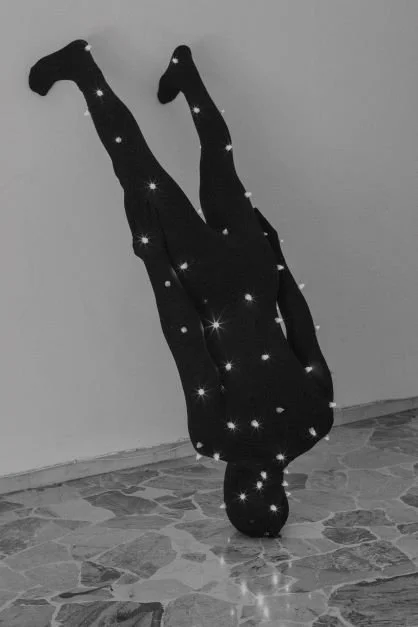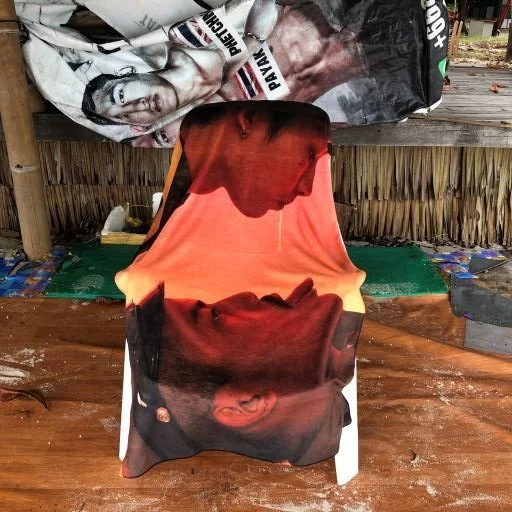Fresh Face: Harit Srikhao
World-building through photography
A&M's Fresh Face is where we profile an emerging artist from the region every month and speak to them about how they kick-started their career, how they continue to sustain their practice and what drives them as artists.
Harit Srikhao in his residency studio in Leipzig, Germany. Image courtesy of the artist.
Harit Srikhao is a storyteller with a distinctive visual language. Born in 1995 in Thailand, his works blend reality and fantasy, often taking local issues and personal experiences as points of departure. His engagement with the medium of photography highlights the complex layers beneath the construction of images and its relationship with propaganda.
Harit holds a BA in Photography and Applied Art at King Mongkut's Institute of Technology Ladkrabang (Bangkok, Thailand) and a master’s degree in Photography and Visual Design from Nuova Accademia di Belle Arti (NABA), Italy. He has exhibited extensively around the world, at Muse de llyse, Switzerland (2015), Kathmandu Photo Gallery, Thailand (2015, 2017), Foam Fotografiemuseum, Netherlands (2017), and Leipzig International Art Programme, Germany (2020), among others. His work is recognised by several international awards including the Prince Claus Seed Award (2021), Young Portfolio in Invisible Photographer Asia Awards (2018) and Foam Talents (2017). Spread from Harit Srikhao’s photobook ‘Whitewash’ (2018), published by AkinaBooks. Image courtesy of the artist.
Spread from Harit Srikhao’s photobook Whitewash (2018), published by AkinaBooks. Image courtesy of the artist.
Spread from Harit Srikhao’s photobook Whitewash (2018), published by AkinaBooks. Image courtesy of the artist.
Whitewash (2015-16) is a significant body of work that exemplifies Harit’s approach. Its title is a nod to the artist’s memory of “Bangkok Big Cleaning Day” in May 2010, that happened after the violent military crackdown against political protesters. Organised by the Bangkok Metropolitan Administration, it was a campaign for volunteers to help the city clean up after the destruction caused by two months of political demonstrations. In this project, Harit revisits his memory of the event and grapples with the propaganda machine that framed his initial response to the protests.
For Harit, “Big Cleaning Day” represented a suppression of guilt from the past, to sweep history under the rug, to whitewash. In an interview with Fountain Ink from 2019, Harit said that “the work is based on the reality of surreal phenomena in Thailand”. He aimed to recapture the emotions of that period, made from fragments which are part recreation and part fantasy. Harit used a range of digital and analogue techniques, such as cut-and-paste collage and chemical manipulation on photo negatives. The outcome are haunting images that hint at the violence exercised, and also the ignorant complicity.
Another recent work that speaks overtly to Thai politics is Scintilla (2018). The work is a tribute to Pakapong Tanyakarn, a young cadet who died from brutal harassment in military school in 2017. Harit restaged the punishment detailed in Pakapong’s journal, visualising the unseen pain endured by the cadet. Here, the figure is seen in a painful headstand position, wrapped by fairy lights. The second work in the series is a collection of photographs of shaved heads, taken from a top-down perspective. In both works, the subject’s identity is removed and their bodies an outlet for violence.
Coincidentally, news of Pakapong’s death broke out during the period of King Rama IX’s royal funeral. Though the two events are unconnected, they bring to the fore how power is embedded into the institutions of monarchy, military and religion.
Harit Srikhao, Bêtes Éternelles, 2022, exhibition view at Gallery VER, Bangkok. Image courtesy of the artist.
Harit Srikhao, Bêtes Éternelles, 2022, exhibition view at Gallery VER, Bangkok. Image courtesy of the artist.
In his solo exhibition Bêtes Éternelles in 2022, Harit showed recent works that look into the state’s attempts at controlling and co-opting the youthful body. The photos of shaven heads in Scintilla are presented as a floor vinyl that puts the audience in the perspective of the abuser, looking down and literally stepping on the heads of young men.
Harit Srikhao, Anima from the Incubus series. Image courtesy of the artist.
This is seen alongside the Anima series, taken at the factory that produced prototypes for national monuments and statues. For these “portraits”, Harit isolated the concrete-cast samples and photographed them against a neutral grey background. Raw and fragmented, they are seen in a different light outside of the mechanisms of propaganda. The concept of life-casting is central to the exhibition, as Harit questions what these bodies are being “moulded into”.
Interview
Harit Srikhao, Whitewash, 2015-16, exhibition view at Foam Talent (2018) at Kasseler Kunstverein, Frankfurt, Germany. Image courtesy of the artist.
How have you maintained your practice since graduating with your Masters in Photography and Visual Design at Nuova Accademia di Belle Arti (NABA) in Milan, Italy?
I am both an artist and professional photographer. While preparing for exhibitions, I also work as a portrait and fashion photographer. Even though the income from photography is not much, it helps me out financially during the research period.
Storytelling is the important intersection between these two media. I think of my photography works like a film or graphic novel. For me, the most exciting moment is seeing my creative universe expand.
“Storytelling is the important intersection between these two media. I think of my photography works like a film or graphic novel.”
Harit Srikhao, Classroom, 2013, exhibition view in Cross_Stitch at Bangkok Art and Culture Centre. Image courtesy of BACC.
Looking back at your photographic output thus far, what was one pivotal early work?
It would be the photo installation titled Classroom (2013), presented at my first group exhibition Cross_Stitch (2013) at Bangkok Art and Culture Centre (BACC). Then, I was in my junior year at King Mongkut’s Institute of Technology Ladkrabang (KMITL), Bangkok, Thailand. The installation is made up of black and white portraits of my classmates, and it is a critique of the Thai education system.
Today, I do not like the work much. However, in hindsight, it shows that I have been interested in photo installation from the beginning.
Who has been a mentor or an important artistic influence?
For the first show at BACC, I was invited by Manit Sriwanichpoom who was my mentor since I was in high school. Other important influence is the legendary photographer Nan Goldin. Her book ‘The Ballad of Sexual Dependency’(1986) completely changed my life.
What was one important piece of advice you were given?
There is a quote from Goldin’s book: "I used to think that I could never lose anyone if I photographed them enough. In fact, my pictures show me how much I've lost.”
Even though my work leans more towards installation and conceptual approaches, I am touched by it and I think that speaks to the value of photography.
Harit Srikhao, Bêtes Éternelles, 2022, exhibition view at Gallery VER, Bangkok. Image courtesy of the artist.
Harit Srikhao, Bêtes Éternelles, 2022, exhibition view at Gallery VER, Bangkok. Image courtesy of the artist.
How did the opportunity for your latest exhibition Bêtes Éternelles at Gallery VER come about? Could you talk about the exhibition premise as well as one challenge you faced preparing for it?
I had a solo exhibition titled Whitewash at VER in 2017, and Bêtes Éternelles was originally set to happen in 2020. However, the onset of Covid-19 postponed the exhibition to 2022. I spent this time further developing the presentation of my works, which can be seen in the use of mirrors, light boxes and a room dedicated to video.
In Bêtes Éternelles, I am thinking about how every dictator is obsessed about the idea of youthful bodies and immortality. This obsession is reflected in statues made during their reign.
Harit Srikhao, Scintilla from the Incubus series. Image courtesy of the artist.
One of the works in the exhibition is Scintilla (2018) which you created as a tribute to Pakapong Tanyakarn. What were your motivations behind producing this work?
Pakapong died during the period of King Rama IX’s funeral, which was epic and wasted a lot of money. Pakapong was a freshman who died from the brutal punishment and harassment he endured at the military cadet school.In the series, I tried to recreate the same punishments that he wrote about in his diary.
“In Bêtes Éternelles, I am thinking about how every dictator is obsessed about the idea of youthful bodies and immortality. This obsession is reflected in statues made during their reign. ”
Recently, you seem to be exploring more materials and an installation-based approach in your work. What prompted this trajectory in your practice?
I’ve been thinking a lot about the difference between seeing photography on screen and on print. These days we are bombarded with too many images. I think classic photography lost its aura and traditional ways of presenting photographs are not enough to convey their aura.
Harit in his studio preparing for Bêtes Éternelles his solo exhibition at Gallery VER, Bangkok, 2022. Image courtesy of the artist.
Bangkok Wet Dream Towel. Image courtesy of Bangkok Wet Dream.
Bangkok Wet Dream is a fashion and lifestyle brand created in collaboration with Adisak Jirasakkasem. How did you two get to know each other? What do such interdisciplinary projects offer to your practice?
I exhibited my fashion photography works with Adisak after returning from Milan in 2019. At the time, I was interested in how fashion could be used to discuss politics. This project happened because we wanted to tell a story with political commentary though a pop medium like fashion.
The name Bangkok Wet Dream plays on the weather in Thailand, where we have only two seasons which are hot and wet. We thought the towel was the most suitable first product.
Could you share your favourite art space or gallery in your country? Why are you drawn to that space?
I love Bangkok City City Gallery. Their audience includes many teenagers, so it is a lot of fun. At the same time, their programme is intellectually rigorous and contemporary. I think they manage a good balance between art and the commercial side of business.
What are your hopes for your own local art scene, and regionally as well?
I would love to see more art venues that merge together with contemporary art and commercial projects. A place where teens and adults come together. A place that makes the arts FUN.













